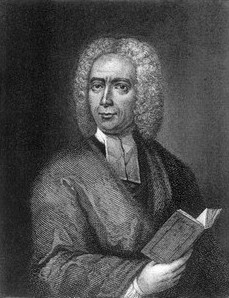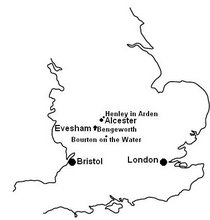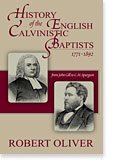Hymns Beddome is most remembered today as a hymn writer. Hymn singing had been something of a controversy among Baptists for much of the first half of the 18th Century. Michael Haykin notes the significance of the fact that John Beddome came out strongly on the side of the singers. (See Haykin, BPB 1, 169).
 |
| Keach |
Benjamin Beddome loved to write poetry and when he became a minister himself he followed the practice of several other ministers of the period, producing a weekly hymn for the congregation to sing following his morning sermon. This was as a supplement to the hymns in Watts’ and Rippon’s Selections. There were no OHPs or printed sheets for everyone then, of course, and so hymns were often ‘lined out’ two lines at a time by the clerk and sung in that fashion. Beddome wrote well over 800 hymns altogether as well as other poems.
The hymns circulated first in manuscript form. In 1769 The Bristol Baptist Collection compiled by John Ash of Pershore (1724-1779) and Caleb Evans of Bristol (1737-1791) was published. It included some 13 hymns by Beddome. In 1787, the influential London pastor John Rippon (1750-1836) produced his famous Selection. This contained some 36 hymns by Beddome. (Cf John Julian, Dictionary of hymnology, 2nd Edition, London, John Murray, 1907, 121. Article by W R Stevenson). The Selection eventually went through many editions.
Some hymns could also be found appended to printed sermons but it was not until more than 20 years after his death that the hymns were collected together and published in one volume. This collection of 830 hymns was published in 1818 by an anonymous editor with an introduction by Robert Hall Junior. It bore the title Hymns adapted to Public Worship or Family Devotion, now first published from the manuscripts of the late Rev Benjamin Beddome MA. It would appear that this collection was assembled chiefly by use of a fascinating collection of notebooks containing a fair copy of each one with dates. A number of loose copies in Beddome’s own hand and from his later years also appear to have been used.
(This material is in the archive at the Angus Library. A librarian has added a note suggesting that Hall’s wife was responsible for preserving these hymns in the ms notebooks. The editor himself mentions receiving the notebooks from the Beddome family and says that the descendants of a Rev W Christian, formerly of Shepshed Baptist Church, Leicester, preserved other hymns. Presumably these latter are the loose papers in Beddome’s own hand (about 40).)
In the book, the editor has divided Beddome’s hymns into some 25 categories, from ‘Perfections of God’ through ‘Scripture doctrines’ and ‘Bible Societies’ through to ‘doxologies’. He begins by listing the first lines of every hymn and at the back gives scriptural and general indices. All this betrays the fact that Beddome wrote on a range of subjects.
As for their quality, the later hymn writer James Montgomery (1771-1854) spoke most appreciatively of these hymns as having one central idea ‘always important, often striking and sometimes ingeniously brought out’. In the preface to his Christian Psalmist, he quotes the first stanza of one of Beddome's hymns as follows,
Let party names no more
The Christian world o'erspread;
Gentile and Jew, and bond and free
Are one in Christ their head.
and makes the remark, 'His name would deserve to be held in everlasting remembrance if he had left no other memorial of the excellent spirit which was in him than these few humble verses.'
Hall wrote of his excellence as a religious poet having been long known and especially commends his variety and the ‘poetical beauty and elevation’ in some hymns and the ‘piety and justness of thought’ in them all. He also refers to ‘beautiful and original turns of thought’ and their experiential depth and breadth. David Breed placed Beddome ‘among the great English hymn writers’ and particularly liked the fresh evangelistic emphasis. (Breed, 149-153). He suggests that one of his best hymns is that which begins
God, in the gospel of his Son,
Makes his eternal counsels known (Hymn 371)
A modern writer says they are ‘noteworthy for their beautiful blend of doctrine and Christian experience. (Robert Oliver, Strict Baptist Chapels of England Vol 5 The Chapels of Wiltshire and the West, London, Fauconberg Press, 1968, 115).
Since Beddome’s time, the hymns have tended to be more popular in the United States than in the UK and no one hymn has ever become very widely known. Early in the 20th Century Julian’s Dictionary claimed that 40 were in current use and lists a further 69 under his entry. On this basis it declares that Beddome exceeds every other Baptist writer in popularity, including Anne Steele, the next most popular.
However, today there are just 8 hymns by Beddome in Grace Hymns (the same number as Anne Steele) and only 2 in Christian Hymns (Anne Steele has 9). Interestingly, New Christian Hymns keeps the two it had and resurrects ‘Who now shall God's elect condemn’ (NCH 630). Grace Hymns includes ‘Father of mercies, bow thine ear’ (Grace 496, CH 433, NCH 455), ‘God in the gospel of his Son’, (Grace 351 – the lone survivor in Praise!), ‘My times of sorrow and of joy’, ‘Let party names no more ...’, ‘Faith ’tis a precious gift’, ‘Witness ye men and angels now’ (Grace 470, CH 407, NCH 428) and the baptismal hymn ‘Buried beneath the yielding wave.
Since Beddome’s time, the hymns have tended to be more popular in the United States than in the UK and no one hymn has ever become very widely known. Early in the 20th Century Julian’s Dictionary claimed that 40 were in current use and lists a further 69 under his entry. On this basis it declares that Beddome exceeds every other Baptist writer in popularity, including Anne Steele, the next most popular.
However, today there are just 8 hymns by Beddome in Grace Hymns (the same number as Anne Steele) and only 2 in Christian Hymns (Anne Steele has 9). Interestingly, New Christian Hymns keeps the two it had and resurrects ‘Who now shall God's elect condemn’ (NCH 630). Grace Hymns includes ‘Father of mercies, bow thine ear’ (Grace 496, CH 433, NCH 455), ‘God in the gospel of his Son’, (Grace 351 – the lone survivor in Praise!), ‘My times of sorrow and of joy’, ‘Let party names no more ...’, ‘Faith ’tis a precious gift’, ‘Witness ye men and angels now’ (Grace 470, CH 407, NCH 428) and the baptismal hymn ‘Buried beneath the yielding wave.
How beautiful is this (Grace 288)
So fair a face bedewed with tears!
What beauty e’en in grief appears!
He wept, he bled, he died for you!What more ye saints, could Jesus do?Enthroned above, with equal glow,His warm affections downward flow;
In our distress he bears a part,
And feels a sympathetic smart.
The most thorough appraisal of Beddome as a hymn writer in recent years is the relatively brief one by J R Watson in his study of the English hymn published in 1999. (J R Watson, 198-202). He says that Beddome made use of both ancient and modern writers and his hymns were ‘more than usually dialogic or intertextual’, meaning that he was something of a plagiarist. Watson claims borrowings from Isaac Watts (1674-1748), George Herbert (1593-1633) and John Newton (1725-1807). He nevertheless praises his admirable and predictable clarity, quoting his baptismal hymn on ‘The signification of baptism’ (Hymn 621). Watson admires
Now we sink beneath the waters,
Emblem of our death to sin;
Thence ascending, grace has taught us,
We our lives anew begin.
He notes the shaping of the verse to the downward and upward movements in baptism, observing that the semicolon ‘signifies the point in the service when the body is actually under the water (it is the non-speaking moment of the verse)’. (Watson, 200). He feels that Beddome spoils himself, however, with an over-didactic fourth verse.
May we feel a change internal,
Wrought by power and grace divine;
Short of this, each form external
Will be found a fruitless sign.
He is happier with the paraphrase of Psalm 1 ‘God’s plantation’ and also admires the way Hymn 54 speaks of Christ.
He waded through the sea
Of overwhelming wrath
That wretched sinners, such as we,
Might be redeemed from death.
He is critical of Beddome’s clarity and balance but accepts that ‘a strong imagination’ is at work more akin to Newton and Cowper and an advance on Doddridge. Often predictable and homiletic, he rises above this elsewhere. Watson picks out the striking description of death in Hymn 777
more akin to Newton and Cowper and an advance on Doddridge. Often predictable and homiletic, he rises above this elsewhere. Watson picks out the striking description of death in Hymn 777
 more akin to Newton and Cowper and an advance on Doddridge. Often predictable and homiletic, he rises above this elsewhere. Watson picks out the striking description of death in Hymn 777
more akin to Newton and Cowper and an advance on Doddridge. Often predictable and homiletic, he rises above this elsewhere. Watson picks out the striking description of death in Hymn 777The active limbs, the comely face,
Turned to a mass of rottenness;
The name forgot, the substance gone,
No more admired, no longer known.
Saviour of souls, could I from thee
A single smile obtain,
The loss of all things I could bear,
And glory in my gain.
Watson sees Beddome as transitional, between the grandeur of Watts and the sensitivity of Cowper [see pics]. The last line, he says, looks back to Watts but the second is akin to Cowper.










